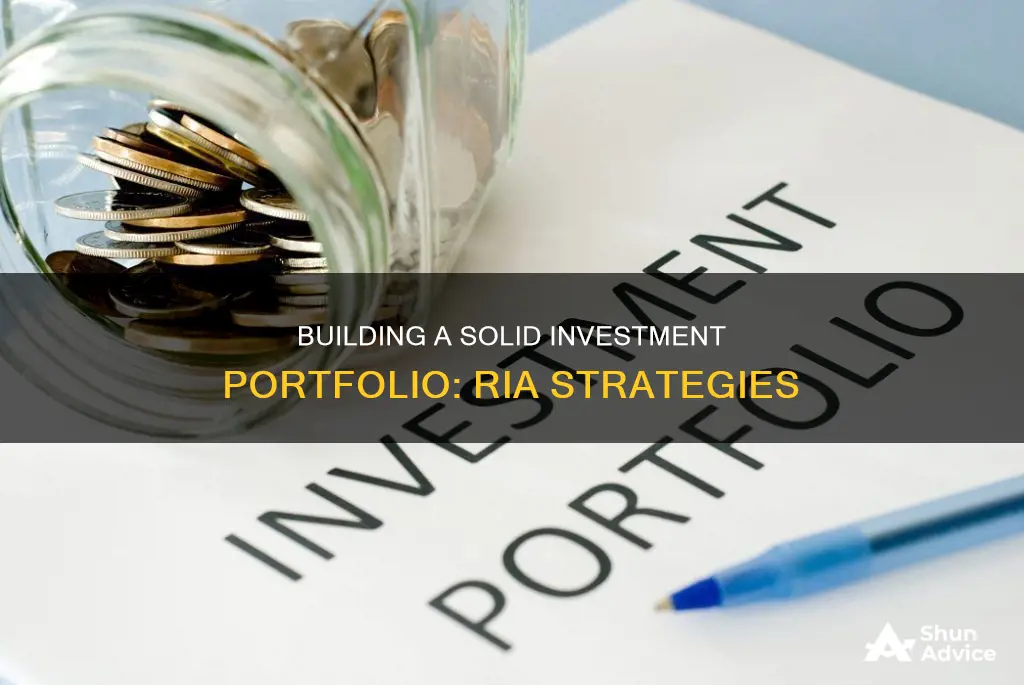
Building an investment portfolio can be a challenging task, but it is crucial to achieving both short-term and long-term financial goals. One key aspect of building a robust portfolio is balancing growth opportunities with risks. This involves understanding your risk appetite and diversifying your investments across various assets such as stocks, bonds, real estate, and commodities. When constructing your portfolio, it is essential to consider your financial goals, investment horizon, and risk tolerance.
Registered Investment Advisors (RIAs) play a vital role in helping investors make informed decisions and achieve their financial objectives. RIAs are professionals or firms that provide investment advice and financial planning services for a fee. They are regulated by the U.S. Securities and Exchange Commission (SEC) and are held to a fiduciary standard, meaning they must act in their clients' best interests.
To become an RIA, individuals must meet specific requirements, including passing the Series 65 exam and registering with the SEC or the appropriate state agency. Additionally, RIAs need to comply with various legal and compliance requirements, such as disclosing fees, managing conflicts of interest, and maintaining comprehensive records.
Building an investment portfolio as an RIA involves understanding your clients' financial goals, risk tolerance, and investment horizons. It is essential to diversify investments across different asset classes and conduct thorough research to assess the risks associated with each investment. Regular monitoring and rebalancing of the portfolio are also crucial to ensure it aligns with the clients' changing needs and market dynamics.
| Characteristics | Values |
|---|---|
| Registration | RIAs must register with the Securities and Exchange Commission (SEC) or state securities regulators, depending on the size of the firm's assets under management (AUM). |
| Fiduciary Duty | RIAs have a fiduciary duty to act in the best interest of their clients at all times. |
| Disclosure | RIAs must disclose all material facts related to their advisory services, including fees, investment strategies, and any conflicts of interest. |
| Recordkeeping | RIAs must maintain comprehensive records of their advisory business, including client agreements, investment recommendations, and other communications with clients. |
| Compliance | RIAs must comply with various rules and regulations related to registration, disclosure, and record-keeping. |
| Anti-Fraud Provisions | RIAs are subject to anti-fraud provisions and are prohibited from engaging in any fraudulent or deceptive practices. |
| Compliance Programs | RIAs must establish and maintain a comprehensive compliance program to ensure they are meeting regulatory requirements. |
| Code of Ethics | RIAs must adopt a code of ethics that outlines ethical obligations and standards of conduct, including provisions related to conflicts of interest, insider trading, and personal trading. |
| Annual Filings | RIAs are required to file annual updates to their registration information, such as Form ADV Part 1 and 2. |
| Examinations | RIAs are subject to periodic examinations by the SEC or state securities regulators to ensure compliance with regulatory requirements. |
What You'll Learn

Diversify your portfolio by investing in stocks, bonds, real estate, commodities and cash
Diversifying your portfolio by investing in stocks, bonds, real estate, commodities, and cash is a crucial strategy to balance risk and optimize returns. Here's a detailed guide on how to achieve effective diversification across these asset classes:
Stocks
Stocks, also known as equities, represent ownership in a company and offer the potential for high returns. However, it's important to spread your investments across different stocks and sectors to minimize risk. Consider investing in a handful of companies you know and trust, and don't be afraid to think globally to broaden your opportunities.
Bonds
Bonds are a type of security that allows you to lend money to a company, entity, or municipality. They are typically less risky than stocks and provide a steady income stream. When investing in bonds, focus on high-quality bonds, such as Treasury bonds and investment-grade corporate debt securities, as they tend to hold up better during economic downturns.
Real Estate
Real estate is a popular alternative investment that includes land and structures. It is often bundled with infrastructure investments in securities like Real Estate Investment Trusts (REITs) or mutual funds. The optimal amount to invest in real estate depends on your individual goals, time horizon, and risk tolerance, but it typically ranges from 10% to 40% of your total net worth.
Commodities
Commodities are another alternative investment option. They include precious metals like gold and silver, as well as agricultural products such as wheat. Commodities can be traded on exchanges or invested in through ETFs or mutual funds.
Cash and Cash Alternatives
Cash and cash alternatives like savings accounts, money market funds, and certificates of deposit (CDs) offer low-risk ways to grow your money with minimal volatility. These investments are suitable for short-term goals where capital preservation is a priority.
Remember, the key to successful diversification is to allocate your investments across various asset classes, sectors, and geographies to minimize risk and maximize returns. The specific allocation percentages will depend on your personal financial goals, time horizon, and risk tolerance.
Savings vs. Investments: What's the Difference?
You may want to see also

Understand your risk tolerance and investment horizon
Understanding your risk tolerance and investment horizon is a critical aspect of building an investment portfolio. It involves assessing how much risk you are comfortable taking on and determining the time period for which you expect to hold your investments.
Your risk tolerance is influenced by factors such as your income, expenses, and willingness to take risks. It can vary from person to person and may change over time as your financial situation evolves. For example, your risk tolerance may increase as your salary increases, or it may decrease as you take on more financial responsibilities or approach retirement age. It's important to periodically reassess your risk tolerance to ensure that your investment portfolio aligns with your current circumstances and comfort level.
The investment horizon refers to the length of time you plan to hold onto a particular investment. This can vary depending on your financial goals and the timeframes associated with them. Short-term goals, such as saving for a vacation or a house renovation, typically have a horizon of less than three years. Mid-term goals, like saving for a child's education, may range from three to ten years. Long-term goals, such as retirement planning or purchasing a house, usually take more than ten years to achieve.
When building your investment portfolio, it's crucial to match your investments with the appropriate time horizon. For short-term goals, you would generally opt for more liquid and less risky investments, such as savings accounts, money market funds, or short-term bonds. On the other hand, long-term goals can accommodate more aggressive and higher-risk investments, such as stocks or real estate.
Additionally, your risk tolerance and investment horizon should be considered together. If you have a longer time horizon, you may be able to tolerate more risk in your portfolio since you have more time to recover from potential losses. Conversely, if you have a shorter time horizon, a more conservative approach is often advisable to minimize the risk of significant losses.
By understanding your risk tolerance and investment horizon, you can make more informed decisions about the types of investments to include in your portfolio, ensuring that your investment strategy aligns with your financial goals and comfort level.
Savings Plans: Invest Now, Reap Long-Term Benefits
You may want to see also

Plan for emergencies and health insurance
Planning for emergencies and getting health insurance are crucial steps in building a robust investment portfolio. Here are some detailed instructions to help you navigate these important aspects:
- Understand the Importance of Emergency Planning: Emergencies can happen at any time, and it's essential to be prepared. Unexpected expenses, such as car repairs or medical bills, can derail your financial goals if you don't have a plan in place. As you build your investment portfolio, ensure you have adequate emergency savings to cover at least three to six months' worth of living expenses. This will provide a financial cushion and help you avoid dipping into your investments prematurely.
- Assess Your Health Insurance Options: When leaving a traditional job to start your own RIA firm, you'll lose the traditional employee benefits, including health insurance. It's crucial to prioritize obtaining health insurance to protect yourself and your family. Research the state insurance exchange options and consider working with an insurance agent to find a suitable policy that fits your needs and budget.
- Consider the Cost of Health Insurance: Health insurance can be one of your largest expenses, especially if you're purchasing it independently. Evaluate the costs of different plans and consider the deductible, monthly premiums, and coverage options. It's important to strike a balance between affordability and adequate coverage to ensure you're prepared for any medical situations that may arise.
- Explore Health Insurance Alternatives: If the cost of traditional health insurance is prohibitive, look into alternative options. For example, joining a professional organization or industry group may provide access to group health insurance plans with more affordable rates. Additionally, if you have a spouse or partner, you might be able to get coverage through their employer's plan.
- Factor Health Insurance into Your Budget: When building your investment portfolio and planning your finances, ensure you allocate sufficient funds to cover your health insurance premiums and any anticipated medical expenses. This will help you stay on track with your financial goals while ensuring you have the necessary coverage.
- Review and Adjust Your Health Insurance Regularly: Health insurance needs can change over time, so it's important to review and adjust your coverage periodically. Life events such as getting married, having children, or experiencing a change in health status may require you to update your insurance plan. Stay proactive and re-evaluate your coverage at least once a year to ensure it aligns with your current circumstances and requirements.
Building an Australian Investment Portfolio: Strategies for Success
You may want to see also

Study the market and assess qualitative risks
When building an investment portfolio, it is crucial to study the market and assess qualitative risks. This involves analysing the potential risks associated with different investments and making informed decisions to create a well-diversified portfolio that aligns with your financial goals and risk tolerance. Here are some key considerations:
Understand the Market
Before investing, it is important to conduct thorough research and analysis of the market. This includes evaluating economic, financial, and global factors that can impact your investments. Study historical and current market trends, performance, and behaviour to identify potential risks and opportunities. Stay informed about industry news, regulatory changes, and market sentiment, as these can influence investment decisions.
Qualitative Risk Assessment
Qualitative risk analysis involves using subjective judgment and expertise to assess the potential risks of an investment. Here are some factors to consider:
- Management Expertise and Reputation: Evaluate the experience, track record, and trustworthiness of the management team. Assess their industry knowledge, decision-making skills, and relationships with stakeholders.
- Industry Cycles and Trends: Understand the industry life cycle and identify potential risks associated with market saturation, new technologies, regulatory changes, or shifting consumer preferences.
- Research and Development: Analyse the company's commitment to innovation, product development, and adapting to market changes. Assess whether their R&D efforts align with future market needs.
- Labour Relations and Company Culture: Consider the company's employee satisfaction, turnover rates, and workplace culture. Positive labour relations and a motivated workforce can contribute to long-term success.
- Customer Satisfaction and Brand Reputation: Evaluate the company's reputation among its customers and the public. Understand their competitive advantage, brand recognition, and any potential risks associated with customer satisfaction or brand image.
- Competitive Analysis: Identify the company's competitors and assess their strengths and weaknesses. Look for unique selling points, intellectual property, or innovative technologies that give the company a competitive edge.
Risk Mitigation Strategies
When assessing qualitative risks, consider implementing risk mitigation strategies such as diversification, asset allocation, and regular portfolio rebalancing. Diversification involves spreading your investments across different asset classes, sectors, and geographic regions to reduce the impact of specific risks. Asset allocation entails allocating your investments based on your risk tolerance, investment goals, and time horizon. Regularly review and rebalance your portfolio to ensure it aligns with your investment strategy and risk profile.
Monitor and Adapt
Stay informed about market changes and regularly review your investment portfolio. Monitor your investments' performance, and be prepared to make adjustments as necessary. Market conditions, economic trends, and external factors can impact your investments, so it is important to stay proactive and adapt your investment strategy accordingly.
Retirement Planning: Understanding 401(k) Investment and Savings Plans
You may want to see also

Minimise portfolio risks through diversification and stop-loss orders
Diversification is a crucial strategy for mitigating risk in an investment portfolio. By spreading investments across different asset classes, investors can reduce overall risk and increase the potential for long-term returns.
Understanding Asset Classes
Asset classes represent different types of investments, each with its own risk and return characteristics.
- Stocks represent ownership shares in publicly traded companies. They offer the potential for high returns but also come with higher risk.
- Bonds are debt instruments issued by governments, municipalities, or corporations to raise capital. They are considered relatively safer investments than stocks and typically provide regular interest payments.
- Real estate investments include residential, commercial, and industrial properties. They offer potential income through rental payments and possible appreciation in property value.
- Commodities include physical goods such as precious metals, oil, natural gas, and agricultural products. Their prices tend to have a low correlation with traditional financial assets, providing diversification benefits.
The Benefits of Diversification
Diversification helps reduce the overall risk of a portfolio by spreading investments across different asset classes. When one asset class declines, others may perform well or remain stable, offsetting potential losses. A diversified portfolio is typically more stable than one concentrated in a single asset class.
Stop-Loss Orders
Stop-loss orders are instructions to sell a security when it reaches a predetermined price. By setting stop-loss orders, investors can limit potential losses by automatically selling an asset if its price falls below a certain threshold. It is important to set appropriate stop-loss levels, taking into account volatility and individual risk tolerance, to avoid triggering unnecessary sales.
In summary, diversification and stop-loss orders are essential tools for minimizing portfolio risks. Diversification spreads investments across asset classes, reducing overall risk and increasing the potential for long-term returns. Stop-loss orders protect against further declines in stock prices, helping to limit potential losses.
CDs: Investment or Saving?
You may want to see also
Frequently asked questions
RIA stands for Registered Investment Advisor. They are registered specialists that provide clients with financial advice and help them achieve their goals in life. RIAs are regulated by the U.S. Securities and Exchange Commission (SEC) or state securities regulators, depending on the size of the firm's assets under management (AUM).
RIAs have a legal obligation to act in their client's best interests, ultimately putting the client's interests before their own. Because RIAs work with fewer clients than many financial advisors, they are often able to offer more personalized attention and customized investment strategies.
Finding a reliable and trustworthy RIA involves conducting thorough research, checking their credentials, and reading reviews and testimonials from current and former clients. You can also search for RIAs in the Investment Adviser Public Disclosure (IAPD) database or the SEC's Investment Adviser Search website.







